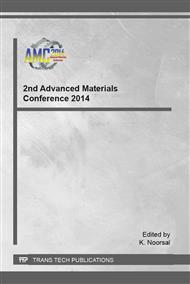p.70
p.75
p.80
p.85
p.90
p.95
p.99
p.103
p.108
Effects of Binder and Processing Parameters on Processability of Porous Ti/HA Composite through Powder Injection Molding
Abstract:
Powder injection molding (PIM) process is suitable for both metal and ceramic materials to produce parts with high volume and accuracy at low cost. In this research work, 90wt. % of Ti6Al4V was dry mixed with 10wt. % of Hydroxyapatite (HA). The resultant mixture was further mixed with different space holders in weight ratio 8:2. The feedstock was prepared by mixing the final mixed powder with PEG and PW based binder systems. The dumbbell shape parts were produced using DSM Xplore injection molding machine. The molded samples were debound into two stages i.e solvent extraction followed by thermal debinding. The debinding parameters were optimized for different binder with space holders. The major binders’ paraffin wax (PW) extracted in haptane and PEG in water immersion at temperatures of 60 °C and 50 °C for 5 hrs respectively. The thermal de-binding was performed successfully at 500 °C by varying the heating rate from 3 °C/min-5 °C/min with holding time 1hr in argon atmosphere followed by the sintering in vacuum. During molding short shot defects and cracks were observed while during debinding, collection of binder, swelling and holes were noted. These types of defects may be due to space holder, improper binder, heating rate, temperature and dwell time at each processing step. The sintered test specimens were analyzed for porosity and microstructure. The results showed that the PEG based binder system with NaCl space holder is more effective to produce porous Ti/HA composite through PIM. Porous Ti/HA composite showed interconnected pores with average size of 90µm.
Info:
Periodical:
Pages:
90-94
Citation:
Online since:
January 2016
Price:
Сopyright:
© 2016 Trans Tech Publications Ltd. All Rights Reserved
Share:
Citation:


